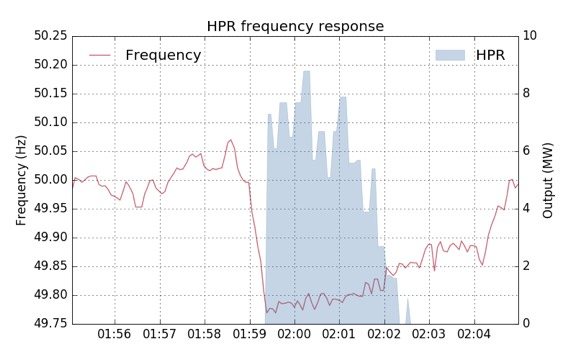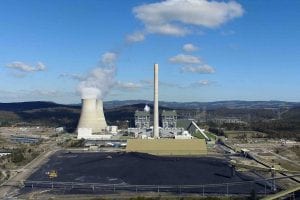(Note: See update on second trip and intervention below).
The Tesla big battery is having a big impact on Australia’s electricity market, far beyond the South Australia grid where it was expected to time shift a small amount of wind energy and provide network services and emergency back-up in case of a major problem.
Last Thursday, one of the biggest coal units in Australia, Loy Yang A 3, tripped without warning at 1.59am, with the sudden loss of 560MW and causing a slump in frequency on the network.
What happened next has stunned electricity industry insiders and given food for thought over the near to medium term future of the grid, such was the rapid response of the Tesla big battery to an event that happened nearly 1,000km away.
Even before the Loy Yang A unit had finished tripping, the 100MW/129MWh had responded, injecting 7.3MW into the network to help arrest a slump in frequency that had fallen below 49.80Hertz.
Data from AEMO (and gathered above by Dylan McConnell from the Climate and Energy College) shows that the Tesla big battery responded four seconds ahead of the generator contracted at that time to provide FCAS (frequency control and ancillary services), the Gladstone coal generator in Queensland.
But in reality, the response from the Tesla big battery was even quicker than that – in milliseconds – but too fast for the AEMO data to record.
Importantly, by the time that the contracted Gladstone coal unit had gotten out of bed and put its socks on so it can inject more into the grid – it is paid to respond in six seconds – the fall in frequency had already been arrested and was being reversed.
Gladstone injected more than Tesla did back into the grid, and took the frequency back up to its normal levels of 50Hz, but by then Tesla had already put its gun back in its holster and had wandered into the bar for a glass of milk.
So why did the Tesla big battery respond when not contracted?
One reason is because it can, and so it did.
The other reason is less clear, but more intriguing. It is contracted to provide such grid services by the South Australia government.
The details of that contract are not released, but it wouldn’t surprise if that contract allowed, or even encouraged, such intervention – just to rub in the message about a cleaner, faster, smarter grid to the technology dinosaurs in the eastern states.
Marvellous stuff.
This is just the latest in a series of interventions since the Tesla big battery was officially opened in early December.
It has provided, at the request of AEMO, 70MW of back-up to help meet a critical peak in the day before its opening, entered into the FCAS market, as we highlight here, and discharged at full capacity.
Over the weekend was again illustrating its rapid fire charging and discharging. (See graph above). The rapid re-bidding is likely to change the market forever, particularly when the 5-minute settlement rule finally comes into effect in 2021.
It should be an interesting 2018.
Note: The Tesla big battery is known to the grid as the Hornsdale Power Reserve, as it is located near the Hornsdale wind farm in South Australia, also owned and operated by Neoen. Hence the acronym HPR in such tables.
Update: We just realised that a paragraph explaining the timings of the Tesla intervention went missing in the transfer from one document to another.
To be clear, on the timing of the response of this generators, some did some minor adjustments (1MW) as part of regulation FCAS, the moment they dropped below 50Hz.
The interesting thing here is the speed with which Tesla responded to the contingency FCAS market, which is triggered after frequency gets to 49.8Hz. That was pretty much instantaneous. And they did it from a standing start, unlike the other generators.
Tesla weren’t officially playing in that market, but just wanted to show what they could do. And they did. That’s what’s impressive, and what’s game changing.
As for timing, Loy Yang A started to lose it at 1.58:59 (NEM time). Its biggest drop, from 364MW to 176MW, was at 1.59:19, which is where frequency hit 49.8Hz, and which is where Tesla came in a matter of milliseconds (but recorded in the 1.59:23 time frame).
Gladstone 1, a contingency FCAS supplier, hopped in at 1.59:27. Loy Yang was down to 44MW by then and completely gone in the next 4 second period.
And no, we never suggested this averted a blackout. The point of the story was what Tesla could do. Now, imagine if there was actually a proper market (fast frequency control) for this stuff.
Latest update: Oops, it happened again! The Loy Yang A number 1 unit, which had been out for maintenance and repairs since tripping in early November, returned to service on Friday morning, and then tripped two and a half hours later.
Again, the Tesla big battery repeated its dose of last week, hopping in with a milli-second respond to help arrest the fall in frequency caused by the sudden loss of 353MW of capacity.
This time, the battery injected 16MW for frequency control before returning to take advantage of the price spike caused by the sudden loss of capacity (prices jumped 50 per cent to $119/MWh).
Again, as we wrote on Thursday, it’s time for the regulators to catch up and actually create a market for Tesla big battery and others like it. That’s the fifth trip of a major coal unit in the past week!.
(Sorry, no new graphs. I’m supposed to be on holidays.









